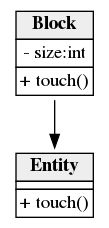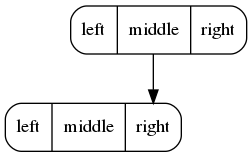graphp / graphviz
GraphViz graph drawing for the mathematical graph/network library GraPHP.
Installs: 2 019 329
Dependents: 74
Suggesters: 16
Security: 0
Stars: 314
Watchers: 14
Forks: 55
Open Issues: 7
pkg:composer/graphp/graphviz
Requires
- php: >=5.3.0
- clue/graph: ~0.9.0|~0.8.0
Requires (Dev)
- phpunit/phpunit: ^6.4 || ^5.7 || ^4.8.35
README
GraphViz graph drawing for the mathematical graph/network library GraPHP.
Development version: This branch contains the code for the upcoming 1.0 release. For the code of the current stable 0.2 release, check out the
0.2.xbranch.The upcoming 1.0 release will be the way forward for this package. However, we will still actively support 0.2.x for those not yet on the latest version. See also installation instructions for more details.
The library supports visualizing graph images, including them into webpages, opening up images from within CLI applications and exporting them as PNG, JPEG or SVG file formats (among many others). Because graph drawing is a complex area on its own, the actual layouting of the graph is left up to the excelent GraphViz "Graph Visualization Software" and we merely provide some convenient APIs to interface with GraphViz.
Table of contents
Quickstart examples
Once installed, let's build and display a sample graph:
$graph = new Graphp\Graph\Graph(); $blue = $graph->createVertex(); $blue->setAttribute('id', 'blue'); $blue->setAttribute('graphviz.color', 'blue'); $red = $graph->createVertex(); $red->setAttribute('id', 'red'); $red->setAttribute('graphviz.color', 'red'); $edge = $graph->createEdgeDirected($blue, $red); $edge->setAttribute('graphviz.color', 'grey'); $graphviz = new Graphp\GraphViz\GraphViz(); $graphviz->display($graph);
The above code will open your default image viewer with the following image:
See also the examples.
Attributes
GraphViz supports a number of attributes on the graph instance itself, each vertex instance (GraphViz calls these "nodes") and edge instance. Any of these GraphViz attributes are supported by this library and have to be assigned using GraPHP attributes as documented below.
For the full list of all GraphViz attributes, please refer to the GraphViz documentation.
Note that all attributes use UTF-8 encoding (Unicode) and will be quoted and
escaped by default, so a ö and > will appear as-is and will not be
interpreted as HTML. See also HTML-like labels below for
more details.
Graph attributes
GraphViz supports a number of attributes on the graph instance itself. Any of
these GraphViz attributes are supported by this library and have to be assigned
on the graph instance with the graphviz.graph. prefix like this:
$graph = new Graphp\Graph\Graph(); $graph->setAttribute('graphviz.graph.bgcolor', 'transparent');
Note how this uses the
graphviz.graph.prefix and not justgraphviz.. This is done for consistency reasons with respect to default vertex and edge attributes as documented below.
For example, the rankdir attribute can be used to change the orientation to
horizontal mode (left to right) like this:
$graph = new Graphp\Graph\Graph(); $graph->setAttribute('graphviz.graph.rankdir', 'LR'); $hello = $graph->createVertex(); $hello->setAttribute('id', 'hello'); $world = $graph->createVertex(); $world->setAttribute('id', 'wörld'); $graph->createEdgeDirected($hello, $world);
See also the examples.
Additionally, this library accepts an optional graphviz.name attribute that
will be used as the name (or ID) for the root graph object in the DOT output if
given. Unless explicitly assigned, this will be omitted by default. It is common
to assign a G here, but usually there should be no need to assign this. Among
others, this may be used as the title or tooltip in SVG output.
$graph = new Graphp\Graph\Graph(); $graph->setAttribute('graphviz.name', 'G'); $graph->createVertex();
Vertex attributes
GraphViz supports a number of attributes on each vertex instance (GraphViz calls
these "node" attributes). Any of these GraphViz attributes are supported by this
library and have to be assigned on the respective vertex instance with the
graphviz. prefix like this:
$graph = new Graphp\Graph\Graph(); $blue = $graph->createVertex(); $blue->setAttribute('graphviz.color', 'blue');
Additionally, GraphViz also supports default attributes for all vertices. Any of
these GraphViz attributes are supported by this library and have to be assigned
on the graph instance with the graphviz.node. prefix like this:
$graph = new Graphp\Graph\Graph(); $graph->setAttribute('graphviz.node.color', 'grey'); $grey = $graph->createVertex();
These default attributes can be overriden on each vertex instance by explicitly assigning the same attribute on the respective vertex instance like this:
$graph = new Graphp\Graph\Graph(); $graph->setAttribute('graphviz.node.color', 'grey'); $blue = $graph->createVertex(); $blue->setAttribute('graphviz.color', 'blue');
Note how this uses the
graphviz.node.prefix and notgraphviz.vertex.. This is done for consistency reasons with respect to how GraphViz assigns these default attributes in its DOT output.
Edge attributes
GraphViz supports a number of attributes on each edge instance. Any of these
GraphViz attributes are supported by this library and have to be assigned on the
respective edge instance with the graphviz. prefix like this:
$graph = new Graphp\Graph\Graph(); $a = $graph->createVertex(); $b = $graph->createVertex(); $blue = $graph->createEdgeDirected($a, $b); $blue->setAttribute('graphviz.color', 'blue');
Additionally, GraphViz also supports default attributes for all edges. Any of
these GraphViz attributes are supported by this library and have to be assigned
on the graph instance with the graphviz.edge. prefix like this:
$graph = new Graphp\Graph\Graph(); $graph->setAttribute('graphviz.edge.color', 'grey'); $a = $graph->createVertex(); $b = $graph->createVertex(); $grey = $graph->createEdgeDirected($a, $b);
These default attributes can be overriden on each edge instance by explicitly assigning the same attribute on the respective edge instance like this:
$graph = new Graphp\Graph\Graph(); $graph->setAttribute('graphviz.edge.color', 'grey'); $a = $graph->createVertex(); $b = $graph->createVertex(); $blue = $graph->createEdgeDirected($a, $b); $blue->setAttribute('graphviz.color', 'blue');
Labels
Vertex labels
By default, GraphViz will always render the vertex ID as the label.
If you do not assign an explicit id attribute to a vertex, this library will
automatically assign a vertex ID starting at 1 in the DOT output and GraphViz
will automatically render this vertex ID as the label. The following example
will automatically assign 1 and 2 as the label:
$graph = new Graphp\Graph\Graph(); $v1 = $graph->createVertex(); $v2 = $graph->createVertex();
If you assign an id attribute to a vertex, this library will automatically
use it as the vertex ID in the DOT output and GraphViz will automatically render
this vertex ID as the label. The following example will automatically assign
blue as the label:
$graph = new Graphp\Graph\Graph(); $a = $graph->createVertex(); $a->setAttribute('id', 'blue');
If you assign a balance attribute to a vertex, this library will automatically
include a label attribute that appends the balance value in parenthesis. The
following example will automatically assign blue (+10) as the label:
$graph = new Graphp\Graph\Graph(); $blue = $graph->createVertex(); $blue->setAttribute('id', 'blue'); $blue->setAttribute('balance', 10);
You can use vertex attributes to explicitly assign a
custom label attribute. Note that any balance value will still be appended
like in the previous example.
$graph = new Graphp\Graph\Graph(); $blue = $graph->createVertex(); $blue->setAttribute('id', 'blue'); $blue->setAttribute('graphviz.label', 'Hello world!');
Note that all attributes will be quoted and escaped by default,
so a > will appear as-is and will not be interpreted as HTML. See also
HTML-like labels below for more details.
Also note that you should either define no vertex IDs at all or all vertex IDs. If you only define some vertex IDs, the automatic numbering may yield a vertex ID that is already used explicitly and overwrite some of its settings.
Edge labels
By default, GraphViz will not render any label on an edge:
$graph = new Graphp\Graph\Graph(); $a = $graph->createVertex(); $b = $graph->createVertex(); $edge = $graph->createEdgeDirected($a, $b);
If you assign a flow, capacity or weight attribute to an edge, this library
will automatically include a label attribute that includes these values. The
following example will automatically assign 100 as the label for the weighted
edge:
$graph = new Graphp\Graph\Graph(); $a = $graph->createVertex(); $b = $graph->createVertex(); $edge = $graph->createEdgeDirected($a, $b); $edge->setAttribute('weight', 100);
The following example will automatically assign 4/10 as the label for an edge
with both flow and maximum capacity set:
$graph = new Graphp\Graph\Graph(); $a = $graph->createVertex(); $b = $graph->createVertex(); $edge = $graph->createEdgeDirected($a, $b); $edge->setAttribute('flow', 4); $edge->setAttribute('capacity', 10);
The following example will automatically assign 4/∞/100 as the label for a
weighted edge with a flow and unlimited capacity:
$graph = new Graphp\Graph\Graph(); $a = $graph->createVertex(); $b = $graph->createVertex(); $edge = $graph->createEdgeDirected($a, $b); $edge->setAttribute('flow', 4); $edge->setAttribute('capacity', null); $edge->setAttribute('weight', 100);
You can use edge attributes to explicitly assign any
custom label attribute. Note that any flow, capacity or weight value will still
be appended like in the previous examples.
$graph = new Graphp\Graph\Graph(); $a = $graph->createVertex(); $b = $graph->createVertex(); $edge = $graph->createEdgeDirected($a, $b); $edge->setAttribute('graphviz.label', 'important');
HTML-like labels
Note that all attributes will be quoted and escaped by default,
so a > will appear as-is and will not be interpreted as HTML. GraphViz also
supports HTML-like labels
that support a subset of HTML features.
GraphViz requires any HTML-like label to be wrapped in < and > and only
supports a limited subset of HTML features as documented above. In order to
prevent automatic quoting and escaping, all HTML-like attribute values need to
be passed with a trailing _html in the attribute name like this:
$graph = new Graphp\Graph\Graph(); $a = $graph->createVertex(); $a->setAttribute('id', 'Entity'); $a->setAttribute('graphviz.shape', 'none'); $a->setAttribute('graphviz.label_html', ' <table cellspacing="0" border="0" cellborder="1"> <tr><td bgcolor="#eeeeee"><b>\N</b></td></tr> <tr><td></td></tr> <tr><td>+ touch()</td></tr> </table>'); $b = $graph->createVertex(); $graph->createEdgeDirected($b, $a); $b->setAttribute('id', 'Block'); $b->setAttribute('graphviz.shape', 'none'); $b->setAttribute('graphviz.label_html', ' <table cellspacing="0" border="0" cellborder="1"> <tr><td bgcolor="#eeeeee"><b>\N</b></td></tr> <tr><td>- size:int</td></tr> <tr><td>+ touch()</td></tr> </table>');
See also the examples.
Record-based nodes
Note that all attributes will be quoted and escaped by default,
so a > will appear as-is and will not be interpreted as HTML. Similar to the
above HTML-like labels, GraphViz also supports simple
record-based nodes
using the record and Mrecord shape attributes and structured label attributes.
GraphViz requires any record-based node label to be quoted, but uses special
syntax to mark record fields and optional port names. In order to prevent
automatic quoting and escaping, all record-based attribute values need to
be passed with a trailing _record in the attribute name like this:
$graph = new Graphp\Graph\Graph(); $a = $graph->createVertex(); $a->setAttribute('graphviz.shape', 'Mrecord'); $a->setAttribute('graphviz.label_record', '<f0> left |<middle> middle |<f2> right')); $b = $graph->createVertex(); $b->setAttribute('graphviz.shape', 'Mrecord'); $b->setAttribute('graphviz.label_record', '<f0> left |<f1> middle |<right> right')); // a:middle -> b:right $edge = $graph->createEdgeDirected($a, $b); $edge->setAttribute('graphviz.tailport', 'middle'); $edge->setAttribute('graphviz.headport', 'right');
See also the examples.
Install
The recommended way to install this library is through Composer. New to Composer?
Once released, this project will follow SemVer. At the moment, this will install the latest development version:
composer require graphp/graphviz:^1@dev graphp/graph:^1@dev
See also the CHANGELOG for details about version upgrades.
This project aims to run on any platform and thus does not require any PHP extensions and supports running on legacy PHP 5.3 through current PHP 7+. It's highly recommended to use PHP 7+ for this project.
The graph drawing feature is powered by the excellent GraphViz
software. This means you'll have to install GraphViz (dot executable).
The Graphviz homepage includes complete
installation instructions for most common platforms, users of Debian/Ubuntu-based
distributions may simply invoke:
sudo apt install graphviz
Tests
To run the test suite, you first need to clone this repo and then install all dependencies through Composer:
composer install
To run the test suite, go to the project root and run:
vendor/bin/phpunit
License
This project is released under the permissive MIT license.




